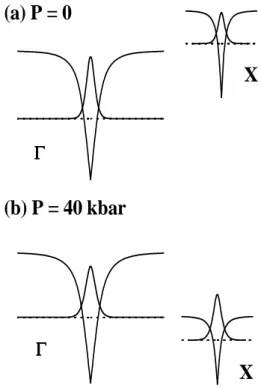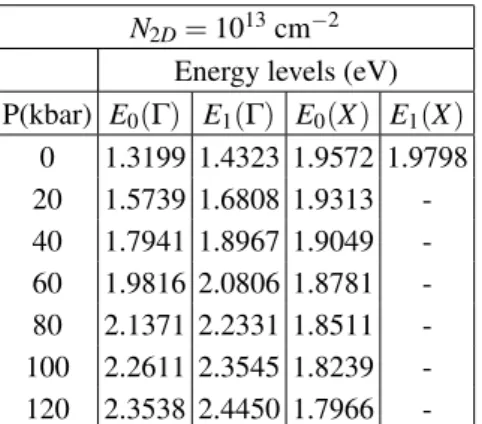866 Brazilian Journal of Physics, vol. 36, no. 3B, September, 2006
Electronic States in n-Type GaAs Delta-Doped Quantum Wells Under Hydrostatic Pressure
M. E. Mora-Ramos1 and C. A. Duque2
1Facultad de Ciencias, Universidad Aut´onoma del Estado de Morelos,
Av. Universidad 1001, C.P. 62210, Cuernavaca, MOR. M´exico 2Instituto de F´ısica, Universidad de Antioquia, AA 1226, Medell´ın, Colombia
Received on 8 December, 2005
The calculation of the electronic energy levels of n-typeδ-doped quantum wells in aGaAsmatrix is presented. The effects of hydrostatic pressure on the band structure are taken into account specially when the host material becomes an indirect gap one. The results suggest that under the applied pressure regime theGaAscan support two-dimensional conduction channels associated to the delta-doping, with carrier densities exceeding 1013cm−2
Keywords: GaAs; Delta-doping; Hydrostatic pressure
I. INTRODUCTION
Ultrathin semiconducting layers with exceptional quality can be obtained with the use of modern crystal growth tech-niques. Impurity seeding is achieved up to the atomic layer scale (δ-doping). The localization of ionized impurities in a very thin layer gives rise to a very intense electric field which -in turns- causes a bending of the energy bands and the occurrence of a particular V-shaped potential. Work on δ-doped structures was primarily in n-type, on Si and III-V semiconducting materials (see, for instance, [1–8]). However, there is also an early report on this kind of system grown on AlxGa1−xAs alloy [9]. In all cases, the main application
sought for these systems is the fabrication of high electron mobility transistors provided the formation of a high density two-dimensional electron gas.
The GaAs-based delta-doped systems are among the most studied both experimentally and from the theoretical point of view. It is known that for the n-type GaAs delta wells, the upper limit for the two-dimensional density of ionized impuri-ties is of about 1013cm−2(see for instance [10] and references therein). This is a saturation limit and above it no additional increase in the electron concentration,N2D, is achieved.
The aim of the present work is to present the calculation of the electron energy levels of n-type delta-doped quantum wells in the conduction band of GaAs, including the effect of hydrostatic pressure. This is done with the use of the local-density Thomas-Fermi approximation [10, 11]. Such approach has proven to be a simple and accurate alternative to self-consistent electronic calculation in the two-dimensional electron gas (2DEG) of delta-doped structures. Details of the model can be found in Refs. [11, 12]. Particular attention will be paid to the effect of the transition from direct to indirect gap as a result of the increasing applied pressure (see Table I). To illustrate the situation, the figure 1 shows, in schematic form, the relative position of theΓandXminima in the GaAs conduction band and the corresponding delta-doped quantum wells for a doping density of 1013cm−2. It can be observed that the ground electronic energy level in the system moves from the Brillouin zone center (atP=0) to locate at theX -point (the transition from direct to indirect energy gap occurs whenPgoes above 36.69 kbar).
P(kbar) 0 40 80 120
EΓ(eV) 1.5189 1.9626 2.2856 2.4880 EX(eV)1.9809 1.9249 1.8689 1.8129
Table I.Γand X energy gaps inGaAsfor different values of the
hydrostatic pressure. Energies are measured from the top valence band edge.
X
ΓΓΓΓ
(b) P = 40 kbar
(a) P = 0
ΓΓΓΓ
X
FIG. 1: Schematic view of the relative disposition of the conduc-tion band minimaΓandX of GaAs, together with the correspond-ing delta-doped quantum wells formed for a two-dimensional ion-ized impurity density of 1013cm−2. (a) represents the situation in
which no hydrostatic pressure is applied to the system. (b) corre-sponds to the case where the pressure is of 40 kbar. For illustration, both the first energy levelsE0(Γ)andE0(X), and their squared
wave-functions, are shown as well.
M. E. Mora-Ramos and C. A. Duque 867
minima with respect to the top of the valence band, the corre-sponding electronic effective masses, and the dielectric con-stant [13].
II. RESULTS AND DISCUSSION
N2D=5×1012cm−2 Energy levels (eV) P(kbar) E0(Γ) E1(Γ) E0(X)
0 1.4098 1.4767 1.9685 20 1.6563 1.7197 1.9417 40 1.8706 1.9312 1.9145 60 2.0533 2.1137 1.8872 80 2.2049 2.2613 1.8598 100 2.3252 2.3801 1.8322 120 2.4152 2.4685 1.8045
Table II. Pressure-dependent energy levels in a δ-doped GaAs
quantum well with a two-dimensional doping concentration
N2D=5×1012cm−2. BothΓand X states are reported. Energies
are measured from the top of the valence band.
Tables II to V show the results of the calculation for the ground and first excited energy levels in n-delta-doped GaAs quantum wells considering the effects of the applied hydrosta-tic pressure. In each case, the formation of the quantum well is assumed for both theΓ andX minima of the conduction band. The idea is to study the conditions for which the ground state in the system will move away from being located at the Brillouin zone center. In order to give a homogeneous picture, the levels are reported considering the zero of the energy scale located at the valence band top edge.
N2D=1013cm−2
Energy levels (eV) P(kbar) E0(Γ) E1(Γ) E0(X) E1(X)
0 1.3199 1.4323 1.9572 1.9798 20 1.5739 1.6808 1.9313 -40 1.7941 1.8967 1.9049 -60 1.9816 2.0806 1.8781 -80 2.1371 2.2331 1.8511 -100 2.2611 2.3545 1.8239 -120 2.3538 2.4450 1.7966
-Table III. The same as in -Table II but with a two-dimensional doping concentration of 1013cm−2.
For two-dimensional densities of 5×1012cm−2(Table II) and 1013cm−2(Table III), it is clearly seen that even for pres-sures above theΓ-Xcrossover, the ground state stays atk=0. More specifically, the ground energy level starts locating at X only for pressures around 60 kbar. The reason for this to happen is that even atP=40 kbar, the changes in theΓband
parameters are not large enough as to cause a significant mod-ification of the quantum well features (energy position of its edge, depth, and average width) in this point of the Brillouin zone.
N2D=5×1013cm−2 Energy levels (eV) P(kbar) E0(Γ) E1(Γ) E0(X) E1(X)
0 - - 1.8768 1.9647
20 - - 1.8573 1.9420
40 - - 1.8357 1.9146
60 - - 1.8128 1.8880
80 - - 1.7888 1.8616
100 1.8322 2.1454 1.7640 1.8343 120 1.9430 2.2505 1.7385 1.8076
Table IV. The same as in Tables II and III for a two-dimensional doping concentration of 5×1013cm−2.
The two mentioned are admissible values for the ionized impurity density in GaAs, according to the above referred studies. It should be noticed that in all the previous litera-ture on the subject the formation of the delta quantum well at Γ for atmospheric pressure is taken for granted. Here, we go beyond and calculate the spectrum of the delta-doped quantum wells assuming the possibility of having densities of 5×1013cm−2 (Table IV) and 1014cm−2 (Table V). The re-sults for the ground level at theΓminimum are only reported in the cases where they arise from a physically meaningful sit-uation within the model. In this sense, even with the increase with pressure of the effective mass, and the decrease of the dielectric constant, the electrical environment in the material -reflected in the effective Bohr radius- will not allow for the formation of a delta well with such characteristics [14] (ob-viously, situations where the quantum well bottom turns out to be below the valence band top can not be accepted). This is equivalent to say that the system saturates and that those values ofN2D-for the given pressures- become unrealistic for
they do not reflects in higher 2DEG densities.
N2D=1014cm−2
Energy levels (eV) P(kbar) E0(Γ) E1(Γ) E0(X) E1(X)
0 - - 1.7865 1.9401
20 - - 1.7738 1.9197
40 - - 1.7575 1.8968
60 - - 1.7386 1.8730
80 - - 1.7178 1.8468
100 - - 1.6956 1.8219
120 - - 1.6722 1.7948
868 Brazilian Journal of Physics, vol. 36, no. 3B, September, 2006
However, such inconvenient is not present in the case of theX minimum. The higher values of the electron effective mass conditions the shape of the quantum well potential pro-file to be wider and not too deep for concentrations well above 1013cm−2. In addition, the ground level of the system always locates at this point. The effective Bohr radius is smaller (at very high pressures it approaches the lattice constant), and it has been already shown that in such a case carrier concentra-tions can reach the order of 1014cm−2 [15, 16]. Therefore, there is the possibility of having high-density electronic chan-nels.
III. CONCLUSIONS
The output of the present calculation indicates that the ap-plication of hydrostatic pressure to GaAs makes possible to attain high density two-dimensional conduction channels as-sociated to theXminimum in the conduction band of that
ma-terial. This is a desirable feature that can lead, for instance, to higher electron mobilities. The results of our work sug-gest that it is worth to perform some experimental study in this direction aiming to determine whether such X-associated conduction channels can be present; if not at normal pressure, at least for the case of an applied one.
IV. ACKNOWLEDGEMENTS
The authors acknowledge support from CONACYT (M´exico) and COLCIENCIAS (Colombia) through bilateral agreement J200.729/2004. This work has been partially sup-ported by CODI-Universidad de Antioquia and by the Excel-lence Center for Novel Materials ECNM, under Colciencias contract No. 043-2005. M.E.M.R. wishes to thank Spanish Ministry of Science and Education for support through grant SAB2004-0199.
[1] E. F. Schubert, A. Fischer, and K. Ploog, IEEE Trans. Electron DevicesED-33(1986) 625.
[2] H. P. Zeidl, T. Wegehaupt, I. Eisele, H. Resinger, G. Tempel, and F. Koch, Appl. Phys. Lett.50(1987) 1164.
[3] R. L. Headrick, B. E. Weir, A. F. J. Levi, D. J. Eaglesham, and L. C. Feldman, Appl. Phys. Lett.57(1990) 2779.
[4] W. -X. Ni, G. V. Hansson, J. -E. Sundgren, L. Hultman, L. R. Wallenberg, J. -Y Yao, L. C. Markert, and J. E. Greene, Phys. Rev. B46(1992) 7551.
[5] H. -J. Gossmann, C. S. Rafferty, A. M. Vredenberg, H. S. Luft-man, F. C. Unterwald, D. J. Eaglesham, D. C. Jacobson, T. Boone, and J. M. Poate, Appl. Phys. Lett. 64(1994) 312; H. -J. Gossmann, and F. C. Unterwald, Phys. Rev. B 47 (1993) 12618.
[6] B. E. Weir, L. C. Feldman, D. Monroe, H.-J. Gossmann, R. L. Headrick, and T. R. Hart, Appl. Phys. Lett.65(1994) 737. [7] L. M. R. Scolfaro, D. Beliaev, P. Enderlein and J. R. Leite, Phys.
Rev. B.50(1994) 8699.
[8] Y. Wang, R. J. Hamers and E. Kaxiras, Phys. Rev. Lett.74
(1995) 403.
[9] E. F. Schubert, C. W. Tu, R. F. Kopf, J. M. Kuo, and L. M. Lunardi, Appl. Phys. Lett.54(1989) 2592.
[10] L. M. Gaggero-Sager and R. P´erez-Alvarez, J. Appl. Phys.78
(1995) 4566.
[11] L. Ioriatti, Phys. Rev. B41(1990) 8340.
[12] L. M. Gaggero-Sager, M. E. Mora-Ramos and D. A. Contreras-Solorio, Phys. Rev. B57(1998) 6286.
[13] See C. A. Duque, N. Porras-Montenegro, Z. Barticevic, M. Pacheco, and L. E. Oliveira, Microelectronics Journal36, 231 (2005), and references therein.
[14] L. M. Gaggero-Sager, M. E. Mora-Ramos, and M. A. Olivares-Robles, Microelect. J.36(2005) 413.
[15] A. Aleksov, A. Vescan, M. Kunze, P. Gluche, W. Ebert, E. Kohn, A. Bergmaier, and G. Dollinger, Diam. Relat. Mater.8
(1999) 941.

